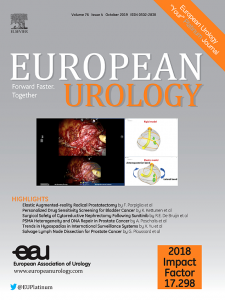Clinical Implications of Basic Research: Exploring the Transformative Potential of Spatial 'Omics in Uro-oncology
IF 25.3
1区 医学
Q1 UROLOGY & NEPHROLOGY
引用次数: 0
Abstract
New spatial molecular technologies are poised to transform our understanding and treatment of urological cancers. By mapping the spatial molecular architecture of tumours, these platforms uncover the complex heterogeneity within and around individual malignancies, offering novel insights into disease development, progression, diagnosis, and treatment. They enable tracking of clonal phylogenetics in situ and immune-cell interactions in the tumour microenvironment. A whole transcriptome/genome/proteome-level spatial analysis is hypothesis generating, particularly in the areas of risk stratification and precision medicine. Current challenges include reagent costs, harmonisation of protocols, and computational demands. Nonetheless, the evolving landscape of the technology and evolving machine learning applications have the potential to overcome these barriers, pushing towards a future of personalised cancer therapy, leveraging detailed spatial cellular and molecular data.
Patient summary
Tumours are complex and contain many different components. Although we have been able to observe some of these differences visually under the microscope, until recently, we have not been able to observe the genetic changes that underpin cancer development. Scientists are now able to explore molecular/genetic differences using approaches such as “spatial transcriptomics” and “spatial proteomics”, which allow them to see genetic and cellular variation across a region of normal and cancerous tissue without destroying the tissue architecture. Currently, these technologies are limited by high associated costs, and a need for powerful and complex computational analysis workflows. Future advancements and results through these new technologies may assist patients and their doctors as they make decisions about treating their cancer.
基础研究的临床意义:探索空间 "全息 "技术在泌尿肿瘤学中的变革潜力。
新的空间分子技术将改变我们对泌尿系统癌症的认识和治疗。通过绘制肿瘤的空间分子结构图,这些平台揭示了单个恶性肿瘤内部和周围的复杂异质性,为疾病的发展、进展、诊断和治疗提供了新的见解。这些平台能够追踪原位克隆系统发育以及肿瘤微环境中免疫细胞的相互作用。整个转录组/基因组/保护组水平的空间分析可产生假设,特别是在风险分层和精准医疗领域。目前面临的挑战包括试剂成本、方案协调和计算需求。尽管如此,不断发展的技术和机器学习应用有可能克服这些障碍,利用详细的空间细胞和分子数据推动未来的个性化癌症治疗。患者摘要:肿瘤很复杂,包含许多不同的成分。虽然我们能够在显微镜下直观地观察到其中的一些差异,但直到最近,我们还无法观察到支撑癌症发展的基因变化。现在,科学家们可以利用 "空间转录组学 "和 "空间蛋白质组学 "等方法来探索分子/遗传差异,从而在不破坏组织结构的情况下观察正常组织和癌症组织区域内的遗传和细胞变化。目前,这些技术受限于高昂的相关成本,以及对强大而复杂的计算分析工作流程的需求。未来通过这些新技术取得的进展和成果可能会帮助患者及其医生做出治疗癌症的决定。
本文章由计算机程序翻译,如有差异,请以英文原文为准。
求助全文
约1分钟内获得全文
求助全文
来源期刊

European urology
医学-泌尿学与肾脏学
CiteScore
43.00
自引率
2.60%
发文量
1753
审稿时长
23 days
期刊介绍:
European Urology is a peer-reviewed journal that publishes original articles and reviews on a broad spectrum of urological issues. Covering topics such as oncology, impotence, infertility, pediatrics, lithiasis and endourology, the journal also highlights recent advances in techniques, instrumentation, surgery, and pediatric urology. This comprehensive approach provides readers with an in-depth guide to international developments in urology.
 求助内容:
求助内容: 应助结果提醒方式:
应助结果提醒方式:


